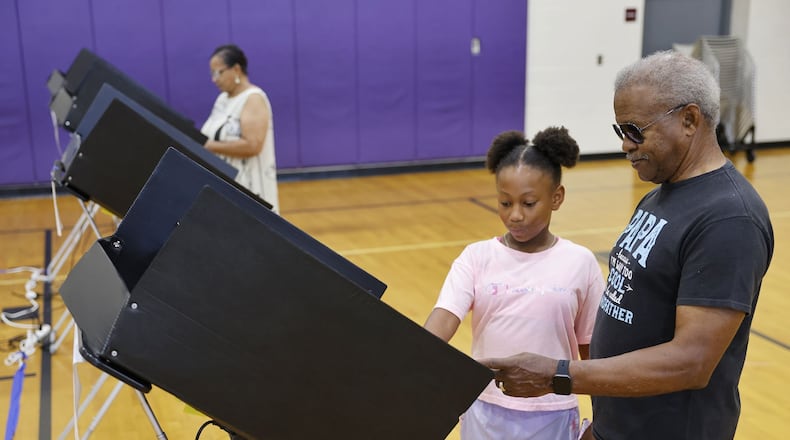Statewide, Issue 1 failed by a 14 point margin, according to final, unofficial results from the Ohio Secretary of State.
In the most populated counties around Dayton, Issue 1 performed worse than statewide Republicans did last November. It failed in Montgomery County by 22 points; failed in Greene County by one point; failed in Clark County by a single vote; and squeaked a win in Butler by .6 points and in Warren by 5.6 points.
In the 2022 election that saw Republican J.D. Vance win his seat in the U.S. Senate, the Middletown native lost Montgomery County by only .2% of the vote. He won Greene by 19.6 points; won Clark by 22.6 points; won Butler by 24.2 points and won Warren by 29 points.
Kyle Kondik, a national elections analyst with the University of Virginia, noted the inherent difference between elections on statewide ballot issues and statewide officials but said that Tuesday’s results were wholly indicative of an underperformance on the Republican side of Issue 1.
“When you see a double-digit loss, there are a lot of things that contribute to that,” Kondik said. “I think that Republicans didn’t have as robust a turnout as they had in, say, 2022, and also I think there was a persuasion problem as well.”
Kondik said Issue 1′s biggest struggle came in traditionally Republican counties with high non-rural populations like Butler, Greene and Warren.
“I thought that Greene (home of Ohio Gov. Mike DeWine) voting no on it was frankly one of the most interesting results in the whole state. Butler barely voted for it, Warren was just a handful of points — Republicans are dependent on getting really big margins out of those places,” Kondik said.
He cautioned against using Issue 1′s results as proof of any real political shifts within the state, iterating that ballot issues in 2023 aren’t indicative of how the state might vote for U.S. senator in 2024, but he said suburban and exurban counties might play similar roles in a vote to protect abortion access this coming November.
Crossover voters
Data from political firm L2 provided further evidence of Republican crossover voters. While voters do not register by political party in Ohio, the firm’s data on early in-person and mail voting indicates that Democrats cast about 50% of ballots before Election Day, compared with 40% by those identified as Republicans. Independents cast the remaining ballots, according to the firm, which models party affiliation using the partisan primary a voter most recently participated in.
Votes cast by mail or in-person before Election Day broke heavily against Issue 1, about 70% to 30%. More than 700,000 votes were cast before Election Day.
Women turned out in higher numbers among those who voted before Election Day, according to L2. In particular, Democratic women comprised the largest share of votes cast in advance, more than Democratic men and Republican men and women.
The No side also appeared to narrowly lead among voters who cast their ballots on Election Day. That, in addition to the lopsided result in the advance vote, created a lead that the Yes side could not overcome.
Local lawmakers react
Local lawmakers on both sides of Issue 1 released statements Wednesday regarding the results.
“Ohioans turned out in unprecedented numbers yesterday and I respect their decision,” state Sen. George Lang, R-West Chester Twp., said. “Nonetheless, our work to protect Ohio’s constitution from bad ideas will continue.”
The region’s lone Democratic state lawmaker, Rep. Willis Blackshear Jr., D-Dayton, issued a statement commending Ohio voters for rejecting Issue 1.
“The people sent the special interests behind this attack on our freedoms a message that was loud and clear: you cannot take away our rights. It’s time for my colleagues in the legislature to set aside divisive, wasteful tactics like Issue 1 and get to work delivering for Ohio’s communities,” Blackshear Jr. said.
Issue 1 backers may try again
In Columbus, the Yes campaign conceded defeat around 9:45 p.m. Tuesday. Campaign Co-chair and Ohio Senate President Matt Huffman, R-Lima, told reporters that the campaign faltered because they didn’t have enough time to educate and sway Republican voters (there were only 90 days between the legislature moving Issue 1 to the ballot and the Aug. 8 election day that the legislature created) and fractured support from well-known Ohio Republicans.
“There were some key folks on our side of the aisle, Republicans especially, who actively opposed this, some pretty vociferously, and then there were key Republicans who simply didn’t support it, who should have been doing so,” Huffman said, naming Republican former governors John Kasich and Bob Taft and former Attorney General Betty Montgomery among those opposed.
Huffman said Issue 1 was a worthwhile and important question to ask Ohio voters — and one that the Ohio General Assembly will likely put on the ballot again, but probably not within the year.
In an interview with Dayton Daily News Tuesday night, Montgomery County Democratic Party Chairman Mohamed Al-Hamdani called the legislature’s proposal a “tremendous overreach.”
“This was a tremendous overreach by the legislature to take the power away from the people,” Al-Hamdani said. “… I think everyday Ohioans sent a strong message that despite the Republicans winning the last few elections, that they still want Ohio to remain a civil and open state where everyday Ohioans have a voice.”
The Associated Press contributed to this report.
About the Author

